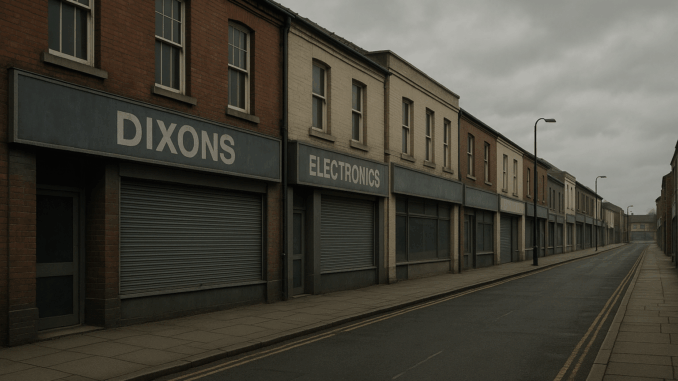
Whatever happened to Dixons? It’s a question I still get from time to time, usually from someone who remembers queuing up for a camcorder in the nineties, or saving for a Walkman after school. As someone who worked the shop floor and later covered the consumer electronics industry as a journalist, I know that Dixons’ story is about more than a brand or a business. It’s about how British families first learned to bring new technology home, and why that magic faded from the high street. Spare a thought for Charles Kalms, who steered Dixons from a single photographic shop in the 1930s to a national institution. His vision helped shape the way a generation discovered technology.
Memories of Dixons: Adverts, Christmas, and the Latest Tech
For many of us, memories of Dixons go beyond the shop floor. We all remember the TV adverts, like the one with the wall of Ferguson TVs showing Jurassic Park in perfect synchronisation, or the parade of the latest gadgets: camcorders, home computers, CD players spinning under spotlights. There was a sense of promise in every new product. In the run-up to Christmas, the excitement in the shop was unmistakable. Kids pressed their noses to the glass to see the first Sega Mega Drive in the window, or marvel at a wall of televisions all showing the same blockbuster. Customers would queue up, clutching copies of the Argos catalogue with certain items circled, then compare them with what Dixons had on display. There was always a buzz when a new system arrived, like the first DVD player or a must-have digital camera. For a lot of families, seeing the Christmas tech adverts meant it was time to start dreaming about what could be under the tree. Those adverts and the window displays became part of the season.
During my retail years, I watched British technology shopping change. In the eighties and nineties, Dixons stood out for making gadgets accessible. It wasn’t always about the best technical choice. Most customers wanted something that would work, fit the budget, and not take all day to set up. Customer after customer wanted practical advice, not a spec sheet. I saw parents compare stereo systems for hours, then settle on the one that sounded good enough and didn’t break the bank. That’s what the shop did best: bridge the gap between engineering dreams and living room reality.
Whatever Happened to Dixons: The Turning Point
So what actually happened to Dixons? By the early 2000s, retail was shifting faster than management could keep up. The launch of online price comparison meant people came in with printouts asking for a price match. Retailers like Amazon chipped away at margins. Shops were under pressure to push warranties and extras instead of focusing on what customers needed. I noticed regulars stopped asking for recommendations. People became more wary of upselling, and the personal connection faded. The magic of wandering around on a Saturday morning with your family, talking to someone who genuinely wanted to help, became less common as targets took priority over service.
How 200 Stores Disappeared Almost Overnight
In 2006, Dixons closed almost two hundred shops at once. Some staff moved to Currys Digital or PC World, but for many, it was the end of an era. I still remember the shock in the staffroom the day we got the news. You could see the writing on the wall. High rents, shrinking profits, and a new generation of buyers who cared more about convenience than loyalty. The old shop floor energy disappeared. Soon after, the website closed too. Dixons as a household name was gone from the high street and online.
Where’s Dixons Now? The Last Outposts and the Meaning of Loss
If you’re travelling through Heathrow or Edinburgh Airport, you might spot a Dixons-branded shop selling headphones and chargers. That’s about all that remains. Currys, PC World, and Dixons eventually became one business, and the Currys name is the only survivor. For most families under thirty, the idea of an electronics specialist on the high street is a foreign concept. The world moved on to algorithm-driven recommendations and next-day delivery.
Why “Whatever Happened to Dixons” Still Matters
The reason this question lingers isn’t just nostalgia. It’s about what British consumers actually lost: trusted advice, a chance to try new tech before buying, and the feeling that you could walk in with no clue and leave a bit more confident. When families ask me whatever happened to Dixons, they’re really asking why shopping for technology lost its personal touch. The answer is in the change from relationship-based selling to anonymous transactions. Dixons represented a time when the high street felt accessible for everyone, not just those who already knew what they wanted.
Final Thoughts: Lessons from the Loss of Dixons
Whatever happened to Dixons? Changing habits, online price pressure, and corporate priorities erased a British icon. But the real lesson is about what families valued: advice you could trust, kit you could try out, and a real person to help when things went wrong. There’s still a place for that, even if the world around us keeps changing. Technology is meant to be for everyone. Dixons made that real for a generation.
For a deeper look at how these stories connect, read our companion feature: Whatever Happened to Maplins?
Further reading:

Leave a Reply